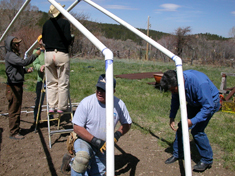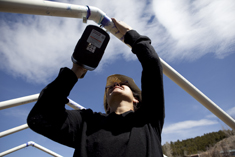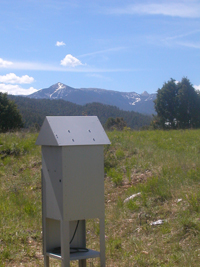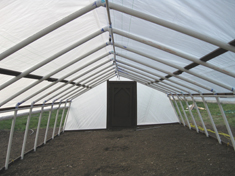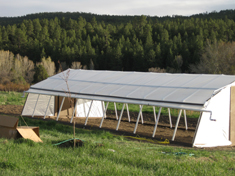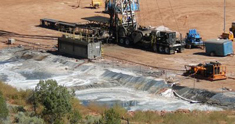 |
|
|
Volume XIV |
May/June 2009 |
Number V |
|
|
Erecting the Hoop HouseEditorial: To Zone or Not To Zone, That is Peñasco's Question By Kay Matthews |
Taos Regional Water Plan, Implementation Phase (We Hope) By Kay Matthews Mora County Residents Gear Up to Fight Oil and Gas Drilling By Kay MatthewsMiranda Canyon Preserve Goes Before Taos County Planning Commission By Kay Matthews |
|
The hoop house will extend our growing season in both the spring and fall. Tomatoes, which we normally have a hard time getting to ripen, are already planted and thriving inside. For more information about the program contact Del Jimenez at 505 852-2668, djimenez@nmsu.edu, or contact your county agent.
Taos Regional Water Plan, Implementation Phase (We Hope)By Kay MatthewsThe Taos Regional Water Plan (TRWP) Steering Committee met on May 28th to prepare for the Interstate Stream Commission (ISC) hearing on the State Water Plan update scheduled in Taos on June 4 and to try to figure out how to segue from a steering committee to an implementation committee. The steering committee is basically comprised of those folks who have continued to participate in the planning process despite the controversy and bad feeling generated when the Public Welfare Implementation Program was jettisoned from the plan (see La Jicarita News, March 2008). All the 16 regional water plans are supposed to report to the ISC on the progress they're making towards implementation, and what water projects they need to meet the implementation goals of their plans. The May 28th meeting, while primarily a reminder of how far we have to go, did reveal some progress on a couple of fronts. The TRWP now has a public information office in conjunction with UNM-Taos at 201 Cruz Alta and the involvement of folks there from the Water Institute. The technical committee, under the leadership of Tony Benson and Taos Soil and Water Conservation District, has been actively engaged in water mapping to assess water supply in the various regions of the planning area. They are trying to complete the work that New Mexico Tech began in the region but whose funding has run out. New Mexico State University's Sam Fernald is also doing a study of how the Hondo Fire near Lama in the 1990s affected that watershed in terms of runoff and aquifer recharge. A lot of time was spent by steering committee members airing concerns about issues that need to be addressed by the TRWP with the general theme that the Taos area has the water resources the rest of the state wants. Therefore, the implementation committees that were appointed at a previous November meeting need to get in action. These include: Watershed Management (getting the Forest Service involved in better thinning and restoration projects); Water Quality Protection (while the Water Quality steering committee has sampled 600 or so deep wells, which have revealed little contamination, it's the shallow wells and septic systems that contain nitrates); Public Education (hopefully the UNM-Taos connection will help disseminate information regarding implementation projects); Protection of Traditional Agriculture (La Jicarita News brought up the ongoing issue of the Forest Service requiring special use permits for acequia projects on Forest land that undermines traditional agriculture); Infrastructure Improvements; Keep Water Rights in the Region (the Top of the World water transfer application by Santa Fe County is still under protest, while several other proposed transfers by that county have been protested or blocked); Growth Management (La Jicarita News also referenced the Taos County Comprehensive Plan that allows neighborhood associations to implement land use planning with the help of county contractor Community by Design, but that there needs to be better outreach and education regarding this opportunity); and Measuring and Monitoring, which will continue the ongoing work of the technical committee. Tempers got a little testy when discussion ensued about the segue from a steering committee to an implementation governance committee, just as they did during the planning process to determine who should represent whose interests. The draft committee currently consists of nine recommended positions: 1) one person to represent the Town of Red River, Questa, and Taos Ski Valley on a rotating basis; 2) a representative from the Town of Taos; 3) one position from El Valle de los Ranchos Water & Sanitation District and El Prado Water & Sanitation District; 4) a representative of Mutual Domestic Water Associations; 5) an acequia representative; 6) one at-large member from the Peñasco Valley; 7) a representative from Taos County; 8) someone to represent the domestic well users; and 9) one at-large member from the northern watershed. While the majority of those present at the meeting agreed to take this list back to their respective communities for input and/or approval, Bruce Kelly from the Taos Ski Valley objected that the three incorporated areas of Red River, Questa, and the Taos Ski Valley had only one representative. Another committee member urged that these appointments be as non-political as possible, making sure that those who end up representing their constituencies be well versed in the TRWP goals and objectives regarding implementation of the plan. This governance committee will oversee the various implementation committees, work on fund raising for water projects, and be the liaison with the ISC. If anyone would like to serve on any of the implementation committees or recommend a representative from their respective communities to serve on the governance committee, contact City of Taos planner Allen Vigil at 575 770-5592 and AVigil2@taosgov.com or County planner Nathan Sanchez at 575 737-6443 and nathan.sanchez@taoscounty.org. The Public Welfare Implementation Program, after being dropped from the TRWP, was codified into a County Ordinance that has yet to come before the County Commission. This ordinance will address the concern that repeatedly came up during the public hearing process on the TRWP: keep water in its area of origin, both within the county as a whole and within its subregions and watersheds. An implementation program would set up an oversight committee to look at all transfers both within and from the region, and based on the public welfare criteria in the Public Welfare Statement, make an informed recommendation to the Office of the State Engineer as to whether the transfer is in the public interest. Mora County Residents Gear Up to Fight Oil and Gas DrillingBy Kay MatthewsAs citizens are doing all over the county, folks in largely rural Mora County have joined together to form an organization to confront the prospect of oil and gas drilling in the area, particularly near Ocate. The group, Drilling Mora County, has sponsored several public meetings and contacted citizens in other areas of the state who have dealt with county regulations that apply to the environmental and social impacts of drilling. During the Bush administration the oil and gas industry was exempted from the Clean Air Act, the Clean Water Act, the Surface Water Run-off Act, the Safe Drinking Water Act, and the Community Right-to-Know Act. Consequently, there is little oversight regarding the hazardous chemicals used in the industry's hydraulic fracturing process and no way of knowing exactly what formula of chemicals is being used (there is currently legislation being drafted to require companies to disclose all chemicals used in the drilling process). Generally, however, radioactive sand is pushed into the ground so that fractures can be traced by the emitted radioactivity. Various chemical solvents, including benzene, xylyne, ethylene glycol (antifreeze), tetramethylamonium chloride, and formaldehyde are used, which can cause cancer in humans (benzene and formaldehyde) and birth defects in fetuses, change DNA, and disrupt endocrine function.
This method also uses enormous amounts of water, as much as a million gallons per well. Each fracturing process -and there can be three per well - uses up to 300,000 gallons of water. And where does that water come from? It comes from the leasee's well, although a lot of folks are unaware of this, as language in industry leases is extremely technical and not readily understood by the lay person. To date, the State Land Office has auctioned approximately 13,000 acres of Mora County to KHL, Inc., of Albuquerque, and Daniel E. Gonzales of Santa Fe. The land was leased for $28 to $50 per acre. Other leases have been signed with private land owners, although the number is not known, as none of the leases have yet been registered with Mora County. Apparently KHL has been having a difficult time figuring out who owns the mineral rights to much of the land in the Ocate area, but the landowners who have signed leases are being paid $2.50 per acre for a ten-year lease. This is close to the same amount paid in the 1950s for oil and gas leases, and much less than is being paid by the industry on the east coast. Mora County is the 17th poorest county in the country. Once the leases are registered, permit requests will fall under Mora County regulations, specifically the Comprehensive Land Use Plan (CLUP) and the Development Guidance System (DGS). (The CLUP is currently being revised with the help of an Albuquerque consulting company, Sites Southwest, to include more specific information on oil and gas permitting.) According to Drilling Mora County's web site, the DGS, drafted after a 1994 public survey, is a strong document designed and developed to protect the agricultural lands and traditions of Mora County from industrial development. Through a comprehensive review involving public input, any development can be turned down if it falls outside the DGS requirements of protecting the culture, water, air, land/soil and human and animal health. According to the group's attorney, Bruce Frederick of the New Mexico Environmental Law Center, the county has jurisdiction over permit requirements for oil and gas drilling on both private land and State Trust Lands. Although the DGS does not specifically reference oil and gas development, there is no question that it could not proceed unless authorized under a "conditional use" permit from the Mora County Land Use Administrator, who should require that applicants complete a "detailed and thorough environmental impact report (EIR)" as part of the process. Subsequently, the Administrator must hold a public meeting to determine whether the applicants and community can agree on permit conditions that would mitigate any adverse effects. The final decision lies with the Board of County Commissioners. As for jurisdiction over State Trust Land, once the property is leased it becomes the lessee's private property under New Mexico state law and consequently, in Frederick's opinion, no special delegation of authority would be required to regulate private oil and gas development. La Jicarita News will cover this issue more extensively in upcoming issues. For more information, go to: drillingmoracounty.blogspot.com. Miranda Canyon Preserve Goes Before Taos County Planning CommissionBy Kay MatthewsWhile La Jicarita News was on its May hiatus the Taos County Planning Commission voted to not recommend preliminary plat approval of the Miranda Canyon Preserve subdivision, the controversial Weimer family development on the former Cristobal de la Serna land grant. However, apparently the Commission failed to follow proper procedure in two respects: (1) the meeting was advertised as a hearing on the developer's request for an exemption on subdivision roads with a higher than 20% gradient, as stipulated in the subdivision ordinance (which the commission approved); and (2) a findings of facts about how specifically the development has failed to meet the requirements of the subdivision ordinance. The Commission will have to hold another meeting to vote on plat approval, which is scheduled for the regular June 9th Planning Commission meeting, after our print deadline. The proposal then automatically goes before the County Commission for its approval, regardless of the Planning Commission's decision to recommend or not recommend (this regulation for subdivisions was enacted several years ago). La Jicarita News kept abreast of the action as a group of local citizens called the Miranda Canyon Watershed Coalition mobilized to take a united stand before the commission. Joel Goodkind and Leo Martinez, residents of Llano Quemado, the entry point of the proposed subdivision, held an organizational meeting in early May (you can listen to both the organizational meeting and the Planning Commission meeting at culturalenergy.org, which has done a great job of covering this issue) and assigned folks to look into a number of concerns to bring before the Planning Commission: impacts on water resources from the more than 100 proposed wells that will be drilled in the faulted hydrogeology of the subdivision; potential traffic congestion in Llano Quemado; cultural and historical impacts, including concerns at Picuris Pueblo; and loss of open space and threatened species in Miranda Canyon. Red Eagle Rael, a former Picuris Pueblo governor, read a statement at the organizational meeting from the current Governor, Richard Mermejo, stating unequivocally that the Pueblo is opposed to the development. There had been confusion about the Pueblo's position due to a letter from the Pueblo in 2007 that requests the Pueblo be allowed to access Weimer property (Miranda Canyon) for the purpose of collecting traditional herbs and with the intention of preserving habitat of wildlife and plant species. That request was granted by the Weimer Properties, LLC, and the agreement is memorialized as Picuris Pueblo Resolution No. 18-07, Rael claimed that only an official letter from the Governor that is approved by the Tribal Council and Tribal Caciques has any authority. The letter from Governor Mermejo was also presented at the Planning Commission meeting. Rumors then began to fly that the developer had made a deal with not only Picuris Pueblo, but Taos Pueblo and the Jicarilla Apache, to adjust the subdivision plat to meet their concerns. However, project manager Barbee sent culturalenergy.org a statement that Picuris Pueblo remains opposed to the development and that there have been no changes to the preliminary plat. There also seems to be some confusion regarding the emergency egress from the subdivision via Forest Road 476. When I spoke with then Camino Real District Ranger John Miera last summer (2008) he indicated that the developer would have to submit a formal request for a special use permit and prove that there was no viable alternative egress route except across public land. But there is a June 2007 Forest Service letter on file in the subdivision application addressed to Weimer Properties granting future homeowners the right to use the existing public road as egress and granting them an exemption from the seasonal closure of FR 476, signed by John Miera. There is also speculation that if the economy continues on its downward trajectory the Miranda Canyon Preserve is going to be in deep financial trouble. Consequently, some folks are hoping that a conservation land trust might be interested in acquiring the property from the Weimer family. If the Planning Commission upholds its previous votes, the road gradient exemption can be appealed but the Planning Department must submit a report on the finding of fact within 30 days, which will go to the County Clerk, and within 30 days from that time will come before the County Commission as a de novo hearing. |
Home | Current Issue | Subscribe | About Us | Environmental Justice | Links | Archive | Index
Copyright 1996-2006 La Jicarita Box 6 El Valle Route, Chamisal, New Mexico 87521.

